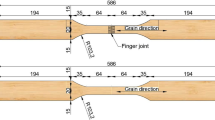Abstract
Two apparatuses developed in our laboratory and based on the same principle are described and tested. They semi-automatically acquire the 3D location of dots making up a network at the surface of wood-products in order to measure the resulting displacement field. The location of each dot is achieved by means of an image analyser coupled with a 2-axis robot to determine the location of the barycentre in the corresponding plan. The third co-ordinate is obtained through a displacement sensor. The accuracy of each device is studied and discussed through the analysis of repeated measurements performed on three products such as: small oak plank (150×120×27 mm), commercial size oak plank (1930×150×30 mm), 3ply cross-laminated douglas fir panel (390×390×6 mm). Two kinds of testing are performed: A-Test without motion of the sample to assess the accuracy in dot detection, and B-Test corresponding to a real measurement where no variation of moisture content has occurred and which theoretically leads to displacements equal to zero.
Zusammenfassung
Zwei Geräte wurden zu diesem Zweck entwickelt, die auf demselben Prinzip beruhen und die hier beschrieben und getestet werden. Sie registrieren die 3D-Position von Messpunkten auf der Oberfläche von Holzprodukten und messen anhand dieses Netzwerks das Verformungsfeld. Die Position der Messpunkte wird mittels Bildanalyse bestimmt. Ein zweiachsiger Roboter bestimmt dabei den Schwerpunkt der entsprechenden Ebene. Die dritte Koordinate wird über einen Dehnungssensor ermittelt. Die Genauigkeit der beiden Geräte wird untersucht und diskutiert anhand wiederholter Messungen an drei Proben: kleines Eichenbrett (150×120×127 mm), handelsübliches Eichenbrett (1930×150×30 mm) und dreilagiges Sperrholz aus Douglasienfurnier (390×390×6 mm). Zwei Prüfverfahren wurden durchgeführt: A-Test ohne Bewegung der Probe, um die Genauigkeit der Bestimmung der Messpunkte abzuschätzen sowie B-Test entsprechend einer realen Messung ohne Feuchteänderung, wobei theoretisch eine Verformung von Null zu erwarten ist.









Similar content being viewed by others
References
AFNOR NF EN 518 (1995) Structural timber Grading Requirements for visual strength grading standards Ed. AFNOR p 11
AFNOR NF EN 1310 (1997) Round and sawn timber Method of measurements of features, Ed. AFNOR p 21
Badel E, Perré P (1999) Détermination des propriétés élastiques d'éléments individuels du plan ligneux du chêne par des essais de traction sur micro-éprouvettes. Ann For Sci 56:467–478
Chao YJ, Sutton MA (1988a) Measurements of strains in a paper tensile specimen using computer vision and digital image correlation. Part 1: Data acquisition and image analysis system. Tappi Journal 71(3):173–175
Chao YJ, Sutton MA (1988b) Measurements of strains in a paper tensile specimen using computer vision and digital image correlation. Part 2: Tensile specimen test. Tappi Journal 71(4):153–156
Constant T, Badia M, Mothe F (2003) Dimensional stability of douglas fir and mixed beech-poplar plywood: experimental measurements and simulations. Accepted for publication by Wood Sci Technol
Farrugia F, Perré P (2000) Microscopic tensile tests in the transverse plane of earlywood and latewood parts of spruce. Wood Sci Technol 34:65–82
Fraser CS, Morrison R, Kinzel R (1999) Deformation measurement of the world's largest electric ring motor, in Proceedings of "Coordinate Measurement System Committee" Seattle, on line http://www.cmsc.org
Lahbabi R (1995) Mesure par analyse d'image de paramètres microscopiques requis pour une prédiction déterministe des propriétés du bois Thèse de l'ENGREF, pp 55–72, juillet 1995
Le Magorou L, Rouger F, Bos F (1999) Elastic and viscoelastic characterisation of wood based panels—Third European Panel Products Symposium—Llandudno UK, Octobre
Le Magorou L, Rouger F, Bos F (2000) Identification de lois de comportement élastique et viscoélastique de panneaux structuraux à base de bois, Les composites à base de bois, Numéro spécial de la Revue des Composites et des Matériaux avancés, Hermès science publications, pp 385–394
Luo PF, Chao YJ, Sutton MA, Peters WH (1993) Accurate measurement of three-dimensional deformations in deformable and rigid bodies using computer vision. Experimental Mechanics 33(2):123–132
Navi P, Rastogi PK, Gresse V, Tolou A (1995) Micromechanics of wood subjected to axial tension. Wood Sci Technol 29:411–429
Palmer G (1998), Accurate test for twist, spring an bow. Queensland Forestry Research Newsletter, Issue n 5, May 1998
Perstorper M, Pellicane PJ, Kliger IR, Johansson G (1995) Quality of timber products from Norway spruce. Part 2: Influence of spatial position and growth characteristics on warp. Wood Sci Technol 29:339–352
Seeling U, Merforth C (2000) FRITS—a new equipment to measure distortion. Holz Roh- Werkstoff 58:338–339
Acknowledgements
The authors are grateful for the financial support provided by the French Forestry Service (ONF) during the research contract "Silviculture and wood quality in sessile oaks "(Co-ordinator: Gérard Nepveu) during the period 1992–1998, and the European Commision during the EU FAIR project Oak-key 1996–1999 (CT 95-0823) "New silvicultural alternatives in young oak high forests. Consequences on high quality timber production "(Co-ordinator: Francis Colin). The experimental part of this work was achieved with the help of Claude Houssement.
Author information
Authors and Affiliations
Corresponding author
Rights and permissions
About this article
Cite this article
Constant, T., Farré, É. Laboratory apparatuses measuring 3D displacement fields involved in distortion of commercial size wood products due to moisture content change.. Holz Roh Werkst 61, 173–181 (2003). https://doi.org/10.1007/s00107-003-0370-0
Published:
Issue Date:
DOI: https://doi.org/10.1007/s00107-003-0370-0




